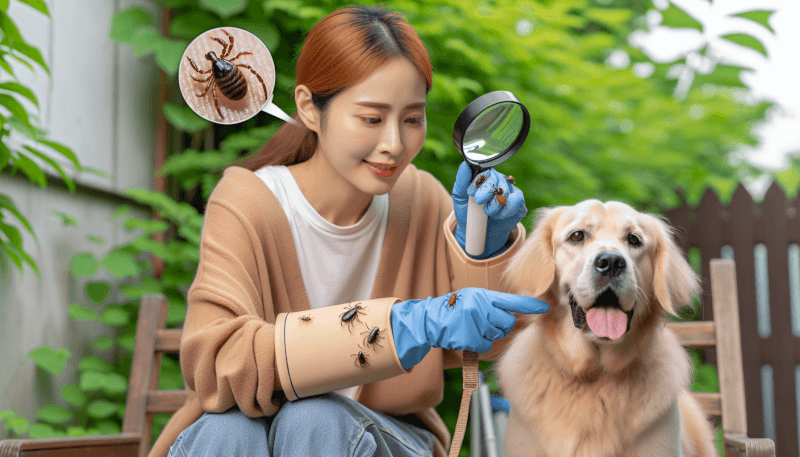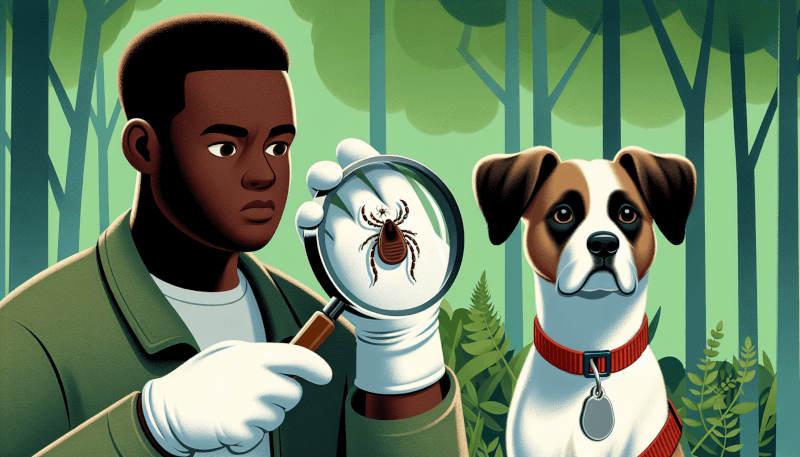When it comes to keeping pesky ticks and fleas away, it pays to be proactive. These tiny critters can make your furry friend uncomfortable and can even lead to health issues. But don’t worry, there are simple steps you can take to prevent these unwanted visitors from finding their way onto your pet and into your home. From regular grooming to using preventative medication, we’ll show you how to keep your pet tick and flea-free, so you can both enjoy a happy and pest-free existence.

Understanding Ticks and Fleas
Ticks and fleas are common parasites that can cause a lot of trouble for both humans and pets. Understanding the types of ticks and fleas is crucial in order to effectively combat and prevent infestations. Ticks are small arachnids that latch onto animals and humans to feed on their blood. There are several species of ticks, including the deer tick, dog tick, and Lone Star tick. Fleas, on the other hand, are wingless insects that also feed on blood. The most common flea species are the cat flea and the dog flea. Knowing about these pests can help you identify them and take appropriate action.
Ready for Cat Trivia?
Test your knowledge about cats!

Lifecycle of Ticks and Fleas
Ticks and fleas have a complex lifecycle that involves different stages. Understanding their lifecycle is vital for effective prevention and control. Both ticks and fleas go through four stages: egg, larva, pupa, and adult. The duration of each stage varies depending on the species and environmental conditions. Female ticks can lay thousands of eggs at a time, and these eggs can hatch into larvae within a few weeks. The larvae then go through a feeding stage before turning into pupae. After the pupal stage, adult ticks and fleas emerge. It is important to note that adult fleas and ticks can survive for long periods without a host, which makes prevention even more crucial.
Diseases Transmitted by Ticks and Fleas
Ticks and fleas are not just a nuisance; they can also transmit dangerous diseases to humans and pets. Some common diseases transmitted by ticks include Lyme disease, Rocky Mountain spotted fever, and babesiosis. Fleas, on the other hand, can transmit diseases such as the bubonic plague and murine typhus. These diseases can have serious consequences if not treated promptly. It is therefore essential to take preventive measures to protect yourself, your family, and your pets from these diseases.
Creating a Tick and Flea-Free Environment
Creating a tick and flea-free environment in your yard is crucial for preventing infestations. Here are some steps you can take to achieve this:
Regularly mow and trim your lawn
Ticks and fleas thrive in tall grass and vegetation. Keeping your lawn well maintained by regular mowing and trimming can reduce their habitat and make it less inviting for these pests.
Remove leaf litter and garden debris
Ticks and fleas love to hide in damp, shaded areas such as leaf litter and garden debris. By regularly cleaning up these areas, you can eliminate potential hiding spots and reduce the chances of infestation.
Keep outdoor areas clean and clutter-free
A cluttered outdoor space provides numerous hiding spots for ticks and fleas. It is important to keep your outdoor areas clean and free from unnecessary clutter. Regularly sweep and remove any fallen leaves, branches, or debris.
Use natural repellents in the yard
There are several natural repellents available that can help repel ticks and fleas from your yard. Cedar wood chips, eucalyptus oil, and neem oil are examples of natural repellents that can be used in your yard to create a hostile environment for these pests.

Protecting Your Home and Indoor Spaces
Ticks and fleas can easily make their way into your home if proper precautions are not taken. Here are some effective measures to protect your home and indoor spaces:
Vacuum your home regularly
Ticks and fleas can hide in carpets, rugs, and upholstery. Regularly vacuuming your home, especially in high traffic areas and pet sleeping areas, can help remove these pests and their eggs.
Wash bedding and pet accessories frequently
Bedding, blankets, and pet accessories such as collars and toys can harbor ticks and fleas. Washing these items frequently in hot water can help kill any pests and prevent infestations.
Seal cracks and gaps in foundations and walls
Ticks and fleas can enter your home through small cracks and gaps in walls and foundations. It is important to seal these entry points to prevent their entry into your living spaces.
Use flea and tick treatment for carpets and furniture
There are many flea and tick treatments available that can be applied directly to carpets and furniture. These treatments kill and repel ticks and fleas, creating a protective barrier in your home.
Preventive Measures for Pets
Protecting your pets from ticks and fleas should be a priority. Here are some preventive measures you can take:
Use veterinarian-approved flea and tick prevention products
Consult with your veterinarian to find the best flea and tick prevention products for your pets. These products can include oral medications, spot-on treatments, and flea and tick collars.
Regularly inspect your pets for ticks and fleas
Frequently check your pets for any signs of ticks or fleas. Run your hands through their fur, paying close attention to areas such as the ears, armpits, and groin where these pests are commonly found.
Bathe and groom your pets regularly
Regular bathing and grooming can help keep your pets clean and reduce the risk of ticks and fleas. Use a pet-friendly shampoo and thoroughly comb through their fur to remove any pests.
Maintain a clean sleeping area for your pets
Ticks and fleas are often found in bedding and sleeping areas. Regularly wash and clean your pet’s bedding and provide a clean and comfortable sleeping area to minimize the risk of infestation.

Avoiding Tick and Flea-Infested Areas
Prevention is always better than dealing with an infestation. Here are some ways to avoid tick and flea-infested areas:
Stay away from tall grass and heavily wooded areas
Ticks and fleas are commonly found in tall grass and heavily wooded areas. Avoid walking or hiking in these areas, especially during peak tick and flea seasons.
Keep pets on designated paths during walks
When walking your pets, keep them on designated paths and avoid allowing them to wander into tall grass or dense vegetation. This can greatly reduce their exposure to ticks and fleas.
Avoid letting pets interact with stray animals
Stray animals can carry ticks and fleas. Avoid allowing your pets to interact with stray animals to minimize the risk of infestations.
Be cautious when visiting tick-prone regions
If you are planning to visit an area known for high tick activity, take extra precautions. Wear appropriate clothing, use insect repellent, and thoroughly check yourself and your pets for ticks after your visit.
Protective Clothing and Accessories
Taking the right clothing and accessories precautions can greatly reduce the risk of ticks and fleas. Here are some tips:
Wear long-sleeved shirts, long pants, and closed-toe shoes
Cover exposed skin by wearing long-sleeved shirts, long pants, and closed-toe shoes when spending time outdoors in tick and flea-prone areas.
Tuck pants into socks or boots
Tucking your pants into your socks or boots can create an extra barrier and prevent ticks from crawling up your legs.
Use insect repellent on exposed skin
Apply an insect repellent that contains DEET or another EPA-approved ingredient to any exposed skin. This can help repel ticks and fleas and reduce the risk of bites.
Utilize flea and tick repellent collars or tags for pets
Collars or tags that are specifically designed to repel ticks and fleas can provide an additional layer of protection for your pets. Consult with your veterinarian to choose the right product for your pet.

Regularly Inspecting and Maintaining Outdoor Areas
Regular inspections and maintenance of your outdoor areas can help detect and prevent tick and flea infestations. Here are some steps to follow:
Inspect your yard for any signs of ticks and fleas
Regularly inspect your yard for any signs of ticks and fleas. Look for clustered insects or bite marks on plants or trees. If you notice any signs, take immediate action to address the issue.
Keep bird feeders away from the house
Bird feeders can attract rodents and wildlife, which in turn can carry ticks and fleas. Keep bird feeders at a distance from your house to reduce the risk of infestation.
Regularly check your outdoor pet housing
If you have outdoor pet housing, such as doghouses or pens, regularly inspect and clean them. Ticks and fleas can hide in these areas, so it’s important to keep them clean and free from pests.
Trim trees and shrubs to reduce tick habitats
Ticks thrive in shaded areas, such as trees and shrubs. Regularly trim trees and shrubs to reduce their habitat and discourage tick infestations.
Treating Infestations
Despite the best preventive measures, infestations can still occur. If you suspect a tick or flea infestation in your home or on your pets, it is important to take prompt action. Here are some steps to follow:
Identify the extent of the infestation
Thoroughly inspect your home and pets to determine the extent of the infestation. Look for signs such as live ticks or fleas, eggs, or bite marks.
Consult a professional pest control service
For severe infestations, it is recommended to seek assistance from a professional pest control service. They have the knowledge and expertise to properly treat and eliminate the infestation.
Clean and disinfect affected areas
Clean and disinfect affected areas in your home, including carpets, furniture, and pet bedding. Use hot water and appropriate cleaning products to kill any remaining ticks or fleas and their eggs.
Treat your pets and their bedding
Consult with your veterinarian to find the most suitable treatment option for your pets. This can include spot-on treatments, oral medications, or medicated baths. Also, wash and treat your pet’s bedding to eliminate any remaining pests.

Educating Yourself on Tick and Flea Prevention
Taking the time to educate yourself on tick and flea prevention is crucial in effectively combating these pests. Here are some steps you can take:
Learn about local tick and flea species
Research and familiarize yourself with the tick and flea species that are prevalent in your area. This knowledge will help you identify and understand the behavior of these pests.
Understand their habits and lifecycle
Learn about the habits and lifecycle of ticks and fleas. This will enable you to implement preventive measures at the appropriate times and target their vulnerabilities.
Stay updated on preventive measures
Stay informed about the latest preventive measures and techniques. Research reputable sources, such as veterinary websites or publications, to keep up with new developments in tick and flea prevention.
Know the signs and symptoms of infestation
Understanding the signs and symptoms of a tick or flea infestation can help you identify and address the problem early on. Common signs include excessive scratching, redness, and bite marks.
Consulting with a Veterinarian
When it comes to protecting your pets from ticks and fleas, consulting with a veterinarian is invaluable. Here are some reasons to seek professional advice:
Seek professional advice for pet-specific prevention
Veterinarians are experts in pet care and can provide valuable advice on specific preventive measures for your pets. They can recommend the most suitable flea and tick products and treatments.
Discuss suitable preventive treatments for pets
Discuss with your veterinarian the most suitable preventive treatments for your pets. Factors such as age, breed, and health condition can influence the choice of treatments. Your veterinarian can help tailor a prevention plan for your pets’ specific needs.
Get recommendations for safe tick and flea products
With so many tick and flea products available in the market, it can be overwhelming to choose the right ones. Your veterinarian can provide recommendations for safe and effective products that are appropriate for your pets.
Address any concerns or questions
If you have any concerns or questions regarding tick and flea prevention, do not hesitate to consult with your veterinarian. They can address any doubts or uncertainties and provide guidance on the best course of action.
By following these comprehensive preventive measures, you can significantly reduce the risk of ticks and fleas in your home and protect your pets and family. Remember, prevention is key, and staying educated and proactive is the best way to keep these pests at bay.


